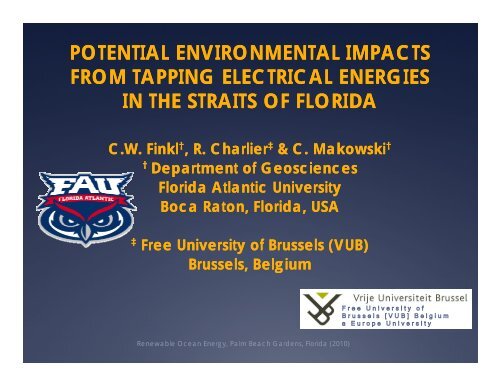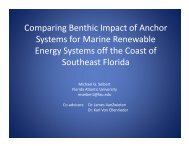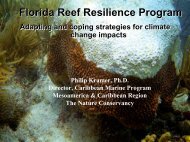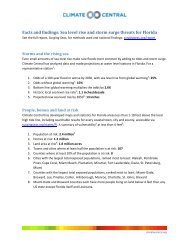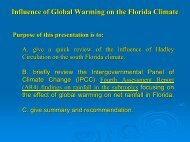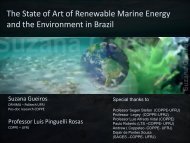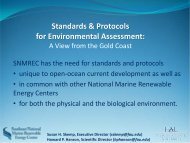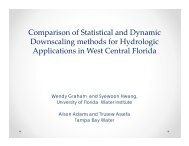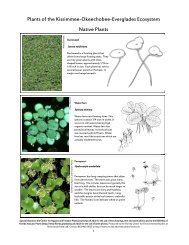Charles Finkl, Potential Environmental Impacts from Tapping Ocean ...
Charles Finkl, Potential Environmental Impacts from Tapping Ocean ...
Charles Finkl, Potential Environmental Impacts from Tapping Ocean ...
- No tags were found...
Create successful ePaper yourself
Turn your PDF publications into a flip-book with our unique Google optimized e-Paper software.
POTENTIAL ENVIRONMENTAL IMPACTSFROM TAPPING ELECTRICAL ENERGIESIN THE STRAITS OF FLORIDAC.W. <strong>Finkl</strong> † , R. Charlier ‡ & C. Makowski †† Department of GeosciencesFlorida Atlantic UniversityBoca Raton, Florida, USA‡ Free University of Brussels (VUB)Brussels, BelgiumRenewable <strong>Ocean</strong> Energy, Palm Beach Gardens, Florida (2010)
PURPOSE AND GOALS• Show relevance of ocean current Energy Production Units (EPU) alongthe southeast Florida coast• Relate the configuration and environments of the continental shelf tocable laying scenarios• Introduce geomorphological maps of the shelf interpreted <strong>from</strong>LADS (Laser Airborne Depth Sounding) bathymetry• Indicate some potential environmental risks of transiting thecontinental shelf with electrical transmission cables• Discuss possible solutions of potential risks tocoastal marine environments caused byconnecting offshore EPUs with the electrical gridonshore
OCEAN CURRENT GENERATEDELECTRICITY: RISKS ANDVULNERABILITIES• Failure of EPU (Energy Production Units)• Maintenance of EPUs (e.g.. removing biofouling films andencrusting organisms such as barnacles)• Hazards to submarines, migrating mammals and fishes• Hazards to surface shipping vessels during maintenance• Damage to sensitive coastal marineenvironments during installationti
THE PROBLEM!• Getting electrical transmission cables ashore <strong>from</strong> EPUs• Crossing sensitive environments on the continental shelfTHE SOLUTION!Learning how to avoid environmentalimpacts by laying electricaltransmission lines ashore across(over, under, through) coral reefs andhard bottoms
STUDY AREAOn Cusp ofNearctic and NeotropicTerrestrial EcoregionsL.OkeechobeeEAAAdjacent to areas defined in the WorldDatabase on Protected AreasFlorida Keys National Marine Sanctuary &associated aquatic preservesAquatic Preserve of Biscayne BayParticularly Sensitive Sea Area (PSSA)Everglades, Big Cypress SwampGulf ofMexicoBig CypressSwampSource:Marine <strong>Environmental</strong> ProtectionCommittee (MEPC) of the InternationalMaritime Organization (IMO)FloridaBayUrban Sprawl – <strong>Ocean</strong> to Everglades Dikes7 million people
SE FLORIDA URBAN CORRIDOR• Adverse impacts <strong>from</strong> over-populating sensitive environments• Vast coastal wetland until post WW II• Atlantic Coastal Ridge urbanized byearly 1900s• Encroachment of wetlands by mid1900s• 50% of Florida Everglades remainsprotected• Today, 7 million people <strong>from</strong> Miami toPalm Beach!• By 2020, population will be 10 million!• They will need electrical energy <strong>from</strong>clean (green) sources• Is ocean power the answer?
COASTAL CITIES – MIAMI, FLORIDAThis is why we need additional clean (blue) ocean energy!Intense Inner City DevelopmentNeeds Electricity to Run
EXAMPLES OF OCEAN CURRENTGENERATED ELECTRICITY EPUs
Marine Current Turbines Ltd.2002-20062006 Installation and testing of the first commercial-scalemonopile-mounted mounted experimental 300kW single 11m diameterrotor system off Lynmouth, Devon, UK.
The DreamFlorida HydroEnergy FarmPopular Mechanics
Early in 2001 marine experts of United Nations organizations listed issues ofglobal concern regarding deterioration of the marine environment:Eutrophication and anoxiaHarmful algal blooms (HABS)Classical contaminants (e.g. sewage, metals, petroleum hydrocarbons)DeforestationIncreased or decreased mobilization of sedimentsDemise of coral reefsLoss of wetlandsHabitat destructionClimate change and sea-level riseInundation as a consequence of physical alterationIncreased risks to human healthReduced biodiversityOverfishingExploitation of coastal mineral resources, particularly sand and gravelLitter-- GESAMP71:09
ZEE BIG QUESTIONS• Can EPUs work in the Environmentof the Florida Current ?• Let’s assume YES so we can focus on environmentalissues!• Are the problems• Technical?• <strong>Environmental</strong>?• Biological?• Psychological?• What are the vulnerabilities?
THE WATCHDOGS?• United States Coral Reef Task Force• Florida Department of <strong>Environmental</strong>Protection• Florida Fish and Wildlife ConservationCommissioni• Southeast Florida Action Strategy Team(SEFAST) for coral reef conservation &management• Southeast Florida Coral Reef Initiative (SEFCRI)
IMPACTS TO PELAGIC &• Trawling for shrimpBENTHIC HABITATS?• Pot fisheries for crabs• Migratory routes for large mammals (e.g.whales, turtles)• Schooling fish, sport fisheries• Florida Reef Tract• Inner continental shelf
REGIONALSETTINGSE Florida AtlanticContinental shelf is about2 km wide at its narrowestpoint off Port Everglades(red arrow) in Port Ever-glades. Shelf drops off to800 m depth after shelfbreak at 30-40m waterdepth.Narrowest part of the shelflies between the two redbars marking northern andsouthern boundaries.
FLORIDA NORTHEAST ATLANTIC COAST85 kmFlorida Currentfarther offshore andlow populationdensity onshore.40 kmThe continental shelf along the northeast Florida coastpresents few problems for bringing electrical transmissionlines ashore because there are no coral reefs. The seafloor isdominated by sand waves and sediment ridges. The widershelf requires that EPUs be located farther offshore, however.
STUDY AREA FOR EPUCABLE ROUTESSoutheast Florida AtlanticContinental Shelf – LADSSURVEY AREA PROVIDESDETAILED INFORMATION ONSEAFLOOR BATHYMETRYThe LADS survey area coversabout 600 km 2 in state watersalong Palm Beach, Broward,and Miami-Dade counties. At itsnarrowest point, the continentalshelf is about 2300 m wide off ofPort Everglades.
Southeast FloridaAtlantic ShelfGrandBahamaUpperSlopeBiscayneBayShelfBreak
LEGEND FOR SEFLORIDA ATLANTICCONTINENTAL SHELF• About 42 geomorphologicalmapping units grouped by• Continental Slope• Coral Reef (Florida Reef Tract)• Hardbottom (Bedrock exposure)• Sand Bottom Forms• Tidal Features• Applied to LADS imagery
RAW DATACOLOR RAMPEDGEOMORPHOLOGICALINTERPRETATION
LADS MAPPING PROCEDUREWindow showingcorrespondence ofmapping units withLADS imagery(bathymetry).Dredge SpoilBeach RidgesSand FlatDiabathic ChannelsSandFlatSandFlatEnd ofDrownedBeach RidgePlainBahamas FractureZoneBeginning i ofFlorida ReefTract
HOW DO WE BRING AN ELECTRICALTRANSMISSION LINE ASHORE?Example of how asurface cable might belaid across the shelf <strong>from</strong>an EPU farm in theStraits of Florida.Note that the cableenters the shelf througha reef gap and thenfollows an inter-reefalreefalsand flat, goes throughanother reef gap, thengoes to Port Evergladesvia the navigationchannel, and then toland.This example poses thefewest environmentalhazards but createsother problems.<strong>Finkl</strong>, C.W., 2004. Leaky valves in littoralsediment budgets: Loss of nearshoresand to deep offshore zones via chutesin barrier reef systems, southeast coastof Florida, USA. Journal of CoastalResearch, , 20(2), 605-611. 611.
THE PROBLEM WITH SURFACE ROUTESON TOP OF THE SEAFLOOR• There is no direct route <strong>from</strong> the EPU farm to the shore• The cable route must pass through a reef gap• Reef gaps do not line up between reef tracts• Reef gaps do not line up with with breaks in hard grounds• Cables laid on sand flats compromise future other uses ofthe sand resource, for beach renourishment for example• The solution? Go underground with directional drillingUNDER the coral reefs and hard grounds
DIRECTIONAL DRILLING UNDER FLORIDA REEF TRACTFrom land under the continentalshelf and out to sea on the slopeFrom sea under the continentalshelf and onto the landConventional wire-line method and conventionalequipment are used without modification.Fixing the direction of drilling can be done easilyby electronic ec c multishot survey devices.
Southeast FloridaAtlantic ShelfGrandBahamaUpperSlopeTransmission LineBiscayneBayShelfBreakExample of a transmission route<strong>from</strong> the Straits of Florida to land
DRILLING THROUGH LIMESTONEPOSES POTENTIAL PROBLEMSLimestones are typically vuggyHoles and cavities in limestones may reach the surface of the coral reefLeakage of drilling fluids (lubricants and additives), muds (e.g. bentoniteclay) can cause sedimentation ti on the coral reef surface smothering reefcommunitiesSolution holesCavity connection with surfaceCavities
IMPACTS OF DRILLING FLUIDSON CORAL REEFSThe skeletal extension and corallite shape ofindividuals id of the Caribbean and Atlantic ti reefbuildingcoral Montastrea annularis (Ellis andSolander) were measured after more than sixweeks' continuous flow-through exposure inlaboratory aquaria to treatments t t of 0, 1, 10 and100-ppm (l 1 -1 ) drilling mud. Linear increase ofthe skeleton (extension rate) and fossa lengthwere significantly depressed in the 100-ppmtreatment. t t Chronic exposure to 100-ppm drillingmud impairs coral skeletal growth rate andpossibly interferes with sediment rejectioncapability by lowering calical relief.Dodge, R.E., 1992. Marine Biology, 71(2), 141-147.
EPA reports potentialadverse impacts of drillingfluids and muds on coralreefs. But, presence ofdrilling muds must bepresent in concentrationstigreater than 100 ppm forfour weeks or longer todamage coral reefs.There is potential forenvironmental damage tocoral reefs <strong>from</strong> leakage ofdrilling fluids and muds, butwaves and currents wouldtend to diminish possibleimpacts along the FRT.
CONCLUSIONS• The future presence of EPUs in the Straits of Florida is a possibility• The the SE Florida conurbation needs ‘Blue Energy’ (<strong>Ocean</strong> Power• Getting electrical transmission lines ashore poses environmentalproblems• Geomorphological maps of the seafloor on the continental shelf willhelp determine the least damaging cable routes• Cable approach routes will have to come ashore:(1) On the surface of the seafloor through Reef Gaps or Reef Gap Ramps(2) In Inter-reefalreefal sand flats and thence through hardgrounds(3) Underneath the FRT via directional drilling <strong>from</strong> land to the continentalslope below the Shelf Break where shelf-edge edge coral reefs occur or(4) From directional drilling offshore through the face of the uppercontinental slope going under the FRT and outcropping on land
THANK YOUFOR YOURATTENTION


